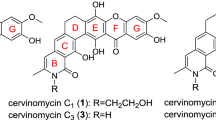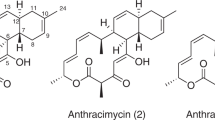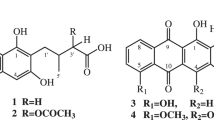Abstract
Three novel members of angucycline family named N05WA963A (1), B (2) and D (4), together with a new anthracycline named N05WA963C (3) were isolated from the culture broth of Streptomyces sp. N05WA963. The structures were elucidated on the basis of comprehensive spectral data analysis. All four compounds have shown antiproliferative effects on a panel of cancer cell lines such as SW620, K-562, MDA-MB-231, YES-4, T-98 and U251SP.
Similar content being viewed by others
Introduction
In the course of our screening program for novel antitumor antibiotics, a fermentation extract of Streptomyces sp. N05WA963 was assayed by a 3-(4, 5-dimethyl-2-thiazolyl)-2, 5-diphenyl-2H-tetrazolium bromide (MTT) method testing for the growth inhibitory activity on the colon cancer cell line SW620. From the production of the strain, four antibiotics named N05WA963A (1), B (2), C (3) and D (4) were purified as the active compounds. Three of them (1, 2, 4) are urdamycin B-type angucyclines having a C-glycosidic moiety without angularic oxygens.1 Whereas, the compound 3 with a linearly condensed ring system belongs to the anthracycline group, and has the same aglycone as an irradiation product of aquayamycin.2 This paper describes the fermentation, isolation, physical properties, structure elucidation and biological activities of these compounds.
Results
Taxonomy
The strain N05WA963 was grown on yeast extract-malt extract agar (ISP2). The vegetative mycelia were brownish yellow and did not show fragmentation into coccoid forms or bacillary elements. The grey aerial mycelia grew abundantly and formed spiral spora chain. The sequence of 16S ribosomal DNA confirmed the strain as a Streptomyces species showing a homology of >99% with type strains of this genus.
Physicochemical properties
Each compound was soluble in methanol, ethanol, acetone, chloroform and ethyl acetate, but insoluble in water, n-hexane and petroleum ether. The other physical properties of these compounds are listed in Table 1. The general features of their UV and NMR spectra resembled each other, especially compound 1, 2 and 4, indicating structural similarities of these compounds.
Structure determination of N05WA963A (1)
N05WA963A (1) was obtained as a dark yellow powder. The UV spectrum of 1 with maxima at λmax 220, 285 and 399 nm in MeOH closely resembled those reported for urdamycin B,3 the representative of angucycline group. The high-resolution FAB-MS (m/z 709.2871[M+H]+, calcd for 709.2860, Δ1.1 mmu error) suggested its molecular formula was C38H44O13. The signal for a phenolic proton at 12.60 p.p.m. in downfield region of the 1H NMR spectrum, as well as the signals at δ188.0 and δ181.7 in the 13C NMR spectrum indicated the location of the hydroxyl group at the α-position of anthraquinone. In addition, one AB-type system (δ7.87 and 7.68, J=7.0 Hz) and a singlet at δ7.67 deduced substitutions at the 4a-, 5-, 8-, 9- and 12b-position of the anthraquinone skeleton. The assumption was confirmed by its HMBC correlations from OH-8 (δ12.60) to C-8, 9, 7, 7a, H-6 (δ7.67) to C-4a, 5, 6a, 7, 12a, H-11 (δ7.68) to C-7a, 11a, 12, 9, 10 and H-10 (δ7.87) to C-8, 11, 11a. In another way, its HMBC correlations from H2-2 (δ2.96, 3.12) to C-1 (δ197.4) and H2-4 (δ2.86, 3.25) to C-4a (δ128.4) with the lack of neighbor coupling between the two pairs of non-equivalent methylene protons suggested that the tertiary methyl and hydroxyl group were both attached to the C-3 position. The absolute configuration of the chiral center at C-3 was deduced to be identical with that of the corresponding center of urdamycinone B,4 the first C-9 C-glycoside of tetrangomycin, by comparing their NMR data. The assignment was also supported by the report that all urdamycins were derived on the same biosynthetic pathway.1 Differing from urdamycinone B, the placement of the methoxy at C-5 (δ160.6) was confirmed by HMBC correlation from the methoxy protons to C-5. The NMR spectra of 1 exhibited the presence of three 6-deoxyhexoses (two of them O-glycosidically, one C-glycosidically at the aromatic ring bonded). Especially diagnostic were three methyl doublets (δ1.29, 1.25, 1.37) and three protons in the typical anomeric region (δ5.09, 5.00, 4.88) in the 1H NMR spectrum, and three signals in the region of anomeric carbons (δ99.1, 99.5, 71.0) of the 13C NMR spectrum. The COSY spectrum suggested the sugar substructures from C-1′ to C-6′, C-1′′ to C-6′′ and C-1′′′ to C-3′′′. In addition, the HMBC correlations from CH3-5′′′ to C-4′′′, C-5′′′, H-5′′′ to C-1′′′, C-4′′′ and H2-3′′′ to C-1′′′, C-2′′′, C-4′′′ ascertained the structure of the terminal sugar. The linkages of the three anomeric carbons were assigned unambiguously by the HMBC correlations from H-1′ to C-9, C-8, C-10, H-1′′ to C-4′ and H-1′′′ to C-4′′. Furthermore, the configurations of the three sugars (the olivose, the rhodinose and the cinerulose A) were proved to be identical with those in saquayamycin C5 by the similarities of their NMR data. The NMR data of 1 were shown in Table 2. Therefore, the overall structure of 1 is determined to be 5-methoxy-urdamycinone B moiety joined at the 4′-hydroxyl with the disaccharide, α-L-cinerulose A-(1 → 4)-α-L-rhodinose (Figure 1).
Structure determination of N05WA963B (2)
N05WA963B (2), was purified as a brown powder with the UV spectrum (Table 1) very similar to that of compound 1. The high-resolution FAB-MS (m/z 483.1656[M+H]+, calcd for 483.1648, Δ0.8 mmu error) showed its molecular formula was C26H26O9. In addition, the NMR spectra of 2 differed from those of 1 only by the absence of signals of cinerulose A and rhodinose residues (Table 3). On the basis of these data, compound 2 is determined to be 5-methoxy-urdamycinone B easily (Figure 1).
Structure determination of N05WA963C (3)
N05WA963C (3), was isolated as a brown powder. Its UV spectrum (Table 1) resembles that of an irradiation product of aquayamycin, dehydrated product IX.2 On the basis of the high-resolution FAB-MS (m/z 695.2628[M+H]+, calcd for 695.2614, Δ1.4 mmu error), the molecular formula was determined to be C37H42O13. The signals for two phenolic protons at 13.10 p.p.m. and 13.04 p.p.m. in the 1H NMR spectrum as well as the signals of two hydrogen-bonded quinone carbonyl carbons at δ187.5 and δ188.0 in the 13C NMR spectrum indicated the locations of the two hydroxyl groups at the α-position of anthraquinone. Furthermore one AB-type system (δ7.85 and 7.91, J=7.5 Hz) and a singlet at δ8.44 suggested substitutions at the 4a-, 5-, 9-, 10- and 12a-position of the anthraquinone skeleton. The HMBC correlations from H-12 to C-1 (δ195.4) and H-4 to C-5 (δ161.4) showed the C-1 (C=O) connecting to the 12a-position and C-4 (CH2) connecting to the 4a-position, respectively. The connection between C-2 and C-1 was established by HMBC correlations from H2-2 to C-1, C-12a. Cross-peaks from H2-2 to C-3, C-4 and H3-13 to C-2, C-3, C-4 in the HMBC experiment connected the subunits and finally determined the structure of A ring. Thus, the angular frame of aglycone had rearranged to a linear one in compound 3. The long range correlations from H-1′ to C-8, C-9 and C-10 in the HMBC spectrum revealed that the pyran ring of the olivose moiety was connected to C-9 through a C-glycosidic linkage. The patterns of olivose, rhodinose and cinerulose A of 3 were identical to those of 1 with the comparison of their NMR data. The NMR data of 3 were summarized in Table 4. The above lines of evidence allowed us to deduce that 3 was a novel member of angucycline group unambiguously containing the same aglycone as dehydrated product IX, which was afforded by UV irradiation of aquayamycin in methanol at room temperature.2 The structure of 3 is in Figure 2.
Structure determination of N05WA963D (4)
N05WA963D (4) was got as a brown amorphism powder with the UV spectrum (Table 1) that exhibited the presence of a skeleton related to angucycline group.1 Its molecular formula, C38H42O13, was established from the high resolution FAB-MS (m/z 707. 2759[M+H]+, calcd for 707.2704, Δ5.5 mmu error). The molecular weight was only 2 mu lower than that of N05WA963A (1). Comparing the NMR data two sp carbons (δ142.8, 127.4) of 4 were instead of the two sp carbons (δ28.3, 33.5) of 1 at 2′′′ and 3′′′, correspondingly the C-1′′′ and 4′′′ were shifted upfield to the expectation, apart from that the leaving signals of 1 and 4 were are very approximate. On the basis of these data, the structure of 4 could be assigned differing from 1 only by the additional dehydrogenations at 2′′′ and 3′′′ confidently. Moreover with the similarities of NMR data the patterns of the olivose, the rhodinose and the aculose in 4 were conferred to be identical to those in saquayamycin A5 (Table 3). Thus the total structure is determined to be 5-methoxy-urdamycinone B moiety joined at the 4′-hydroxyl with the disaccharide, α-L-aculose-(1 → 4)-α-L-rhodinose (Figure 1).
Cytotoxicity to human cancer cell lines
In the MTT assay, the four compounds 1–4 and aquayamycin showed growth inhibitory activities on a panel of cancer cell lines such as SW620, K-562, MDA-MB-231, YES-4, T-98 and U251SP (Table 5). The IC50 values of compound 4 against proliferations of above cell lines were 1.0, 1.5, 2.8, 4.0, 3.1, 3.3 μM, respectively, which were lower than those of compounds 1–3 and aquayamycin.
Discussion
The angucycline family of antibiotics is a large and ever-growing group of secondary metabolites of microbial origin containing more than 100 members. Structurally, these compounds consist of polyketide origin possessing benz[α]anthracene nuclei and several C-glycosidic or O-glycosidic linkages.1 In addition to diverse structural features, they also display a broad range of biological activities, such as antitumor,7, 8 enzyme inhibitory,9, 10 blood platelet aggregation inhibitory11 and antimicrobial.8, 12 On the other hand, anthracyclines are widely used as antitumoral agents, for example, doxorubicin with ID50 of 1.02 μM against K-562 cells in vitro.13 Our findings provide four novel chemical entities: three angucyclines and one anthracycline with cytotoxicity against six cancer cell lines: SW620, K-562, MDA-MB-231, YES-4, T-98 and U251SP. The activity of compound 4 in our assay was higher than those of compounds 1–3 and aquayamycin. The preliminary bioactivity evaluation indicated that these compounds might serve as useful leads in the development of new anti-cancer pharmaceutical agents.
Methods
Reagents and cell lines
MTT was purchased from Sigma (St Louis, MO, USA). Human colorectal cancer cell line SW620, human leukemia cell line K-562, human breast cancer cell line MDA-MB-231 were purchased from American Type Culture Collection (Rockvill, MD, USA). Esophageal carcinoma cell line YES-4, human brain nerve colloid tumor cell line T-98 and human brain nerve colloid tumor cell line U251SP were obtained from medical college of Japan Chiba University. RPMI1640 medium was purchased from Sigma. Aquayamycin was supplied by the antibiotics library in New Drug Research and Development Center, North China Pharmaceutical Group Corporation.
Analytical measurement
Observation of mycelia was performed using a CX31RTSF microscope (Olympus Corporation, Tokyo, Japan). UV spectra were recorded with a Lambda 35 UV/VIS spectrometer (Perkin Elmer Life Sciences, Turku, Finland). HR-FAB-MS were measured with a Thermo scientific LTQ FT mass spectrometer (Thermo fisher scientific, Somerset, New Jersey, USA). The 1D and 2D NMR spectra were measured on a Varian Inova-500 spectrometer (Varian, Palo Alto, CA, USA) using tetramethylsilicane (TMS) as an internal standard. HPLC was performed using a Waters HPLC system equipped with a 996 photodiode array detector (Waters, Milford, MA, USA). Absorbance values in MTT test were recorded with a Wallac Victor2 1420 plate reader (Pekin Elmer Life Sciences, Turku, Finland).
Taxonomic studies
The investigative strain N05WA963 was isolated from a soil sample collected in Yunnan Province, China. For morphological observation, strain N05WA963 was cultured on ISP2 media at 28 °C for 14 to 21 days. Mycelia were observed using a light microscope.
For phylogenetic study, fresh cells were ground to get a uniform suspension. Preparation of genomic DNA and amplification of the 16S ribosomal DNA were performed according to the procedure described by Xu.6 The primer pair 27f (5′-AGAGTTTGATCCTGGCTCAG-3′) and 1492r (5′-TACGGCTACCTTGTTACGACTT-3′) was used for amplification of the almost complete 16S ribosomal RNA gene.
Fermentation of strain N05WA963
Spores obtained from a well-sporulated slant of this organism were inoculated to the medium which consisted of soluble starch 2.4%, glucose 0.1%, peptone 0.3%, beef paste 0.3%, yeast extracts 0.5% and CaCO3 0.4% (pH7.0 before sterilization), and were shake-cultured at 28 °C for 72 h in 500-ml Erlenmeyer flasks containing 100 ml of the medium described above. Thereafter, 5 ml portions of this seed culture were transferred into 500-ml Erlenmeyer flasks, which contained 100 ml of a ferment medium consisting of soluble starch 4.0%, bean powder 2.0%, corn steep liquor 0.5%, KH2PO4 0.05%, FeSO4•7H2O 0.05%, KCl 0.03% (pH 6.5 before sterilization) and then were incubated at 28 °C for 144 h on a rotary shaker at 220 r.p.m.
Isolation procedure for angucycline group compounds
The fermentation broth of flasks was harvested to total volume of 4.0 l and centrifuged at 3000 r.p.m. for 15 min to separate filtrate and mycelia. The filtrate was extracted with ethyl acetate. The mycelia were extracted with 70% acetone. After the insoluble mycelia were removed by centrifugation, the acetone was evaporated and the remaining aqueous solution was extracted with ethyl acetate. The all above ethyl acetate layers were combined and concentrated to yield a brown residue (1.8 g). The residue was subjected to a silica gel flash column and eluted with a gradient of chloroform–methanol from 100:1 to 10:1. The fractions, including active materials, were collected and evaporated to afford 0.5 g brown residue. The residue was applied on a preparative reversed-phase-HPLC column (detection: UV at 254 nm; column: Phenomenex (Torrance, CA, USA) C18, 10 μm, 21.2 × 250 mm; mobile phase: a linear gradient of 30% acetonitrile–water to 60% acetonitrile–water over 10 min, then 60% acetonitrile–water over 30 min; flow rate: 16.0 ml min−1) to obtain four pure compounds: 9.1 mg of N05WA963A (1), 17.0 mg of N05WA963B (2), 15.1 mg of N05WA963C (3) and 13.4 mg of N05WA963D (4), respectively. The retention time of each compound is shown in Table 1.
Assay for cytotoxicity on cancer cell lines
Cytotoxicity of the compounds was examined using a MTT method.14 All cell lines were routinely cultured and passaged in RPMI1640 medium supplemented with 10% new calf serum and 2 mM L-glutamine at 37 °C in a humidified atmosphere of 5% CO2. For cytotoxicity assay, 100 μl of SW620, K-562, MDA-MB-231, YES-4, T-98 or U251SP cells were seeded in 96-well plates at 1 × 104 cells per well and incubated with series of dilution of test compounds for 3 days. After treatment, cells were then incubated with 5 mg ml−1 MTT solution for 4 h. In all, 100 μl of 10% sodium dodecyl sulfate solution was added to the culture and the absorbance at 570 nm was measured on the plate reader. The IC50 values were obtained from the inhibition curve against various concentrations of test compounds.
References
Rohr, J. & Thicricke, R. Augucycline group antibiotic. Nat. Prod. Rep. 9, 103–137 (1992).
Sezaki, M., Kondo, S., Maeda, K. & Umezawa, H. The structure of aquayamycin. Tetrahedron 26, 5171–5190 (1970).
Drautz, H. & Zahner, H. Metabolic products of microorganisms. 234 Urdamycins, new angucycline antibiotics from Streptomyces fradiae. I. Isolation, characterization and biological properties. J. Antibiot. 39, 1657–1669 (1986).
Rohr, J. & Zeeck, A. Metabolic products of microorganisms. 240. urdamycins, new angucycline antibiotics from Streptomyces fradiae. II. Structural studies of urdamycins B to F. J. Antibiot. 40, 459–467 (1987).
Uchida, T. et al. Saquayamycins, new aquayamycin-group antibiotics. J. Antibiot. 38, 1171–1181 (1985).
Xu, L. H., Li, W. J., Liu, Z. H. & Jiang, C. L. Actinomycete Systematic: Principle, Methods and Practice 93–149 (Science Press, Beijing, 2007).
Abdelfattah, M. S., Kharel, M. K., Hitron, J. A., Baig, I. & Rohr, J. Moromycins A and B, isolation and structure elucidation of C-glycosylangucycline-type antibiotics from Streptomyces sp. KY002. J. Nat. Prod. 71, 1569–1573 (2008).
Maruna, M. et al. Isolation, structure elucidation and biological activity of angucycline antibiotics from an epiphytic yew Streptomycete. J. Basic Microbiol. 50, 135–142 (2010).
Alvi, K. A., Baker, D. D., Stienecker, V., Hosken, M. & Nair, B. G. Identification of inhibitors of inducible nitric oxide synthase from microbial extracts. J. Antibiot. 53, 496–501 (2000).
Sekizawa, R. et al. Isolation of novel saquayamycins as inhibitors of farnesyl-protein trasferase. J. Antibiot. 49, 487–490 (1996).
Kawashima, A. et al. PI-083, a new platelet aggregation inhibitor. J. Antibiot. 41, 1913–1914 (1988).
Abdelfattah, M., Maskey, R. P., Asolkar, R. N., Grun, W. I. & Laatsch, H. Seitomycin: isolation, structure elucidation and biological activity of a new angucycline antibiotic from a terrestrial Streptomycete. J. Antibiot. 56, 539–542 (2003).
Biscardi, M. et al. In vitro antileukemic effect of a new anthracycline analogue, MEN 11079. Leuk. Res. 27, 1125–1134 (2003).
Mosmann, T. Rapid colorimetric assay for cellular growth and survival: application to proliferation and cytotoxicity assays. J. Immunol. Meth. 65, 55–63 (1983).
Acknowledgements
This work was supported by the grants from the National Basic Research Project of China (Grant 2009CB526513), National New Drug Research and Development Project (Grant 2008ZX09401-05, 2010ZX09401-403). We are grateful to the colleagues from the New Drug Research and Development Center, North China Pharmaceutical Group for their support especially Mr Dong Guo and Ms Shiqing Zhu for NMR and MS measurements and Mr Yunlong Mu, Ms Chaojing Cai and Ms Yueqi Shan for the actinomycete collection and fermentation. We thank Dr Mei Dong (School of Pharmaceutical Sciences, Hebei Medical University) for cytotoxicity assay in part.
Author information
Authors and Affiliations
Corresponding author
Rights and permissions
About this article
Cite this article
Ren, X., Lu, X., Ke, A. et al. Three novel members of angucycline group from Streptomyces sp. N05WA963. J Antibiot 64, 339–343 (2011). https://doi.org/10.1038/ja.2011.4
Received:
Revised:
Accepted:
Published:
Issue Date:
DOI: https://doi.org/10.1038/ja.2011.4
Keywords
This article is cited by
-
Cytotoxic antibiotic angucyclines and actinomycins from the Streptomyces sp. XZHG99T
The Journal of Antibiotics (2018)





